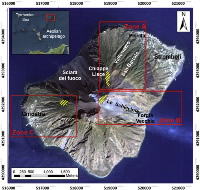From hot rocks to glowing avalanches: Numerical modelling of gravity-induced pyroclastic density currents and hazard maps at the Stromboli volcano (Italy)
Salvatici T., A. Di Roberto, F. Di Traglia, M. Bisson, S. Morelli, F. Fidolini, A. Bertagnini, M. Pompilio, O. Hungr, N. Casagli (2016).
Geomorphology 273, 93-106, http://dx.doi.org/10.1016/j.geomorph.2016.08.011.
Abstract
Gravity-induced pyroclastic density currents (PDCs) can be produced by the collapse of volcanic crater rims or due to the gravitational instability of materials deposited in proximal areas during explosive activity. These types of PDCs, which are also known as “glowing avalanches”, have been directly observed, and their deposits have been widely identified on the flanks of several volcanoes that are fed by mafic to intermediate magmas. In this research, the suitability of landslide numerical models for simulating gravity-induced PDCs to provide hazard assessments was tested. This work also presents the results of a back-analysis of three events that occurred in 1906, 1930 and 1944 at the Stromboli volcano by applying a depth-averaged 3D numerical code named DAN-3D. The model assumes a frictional internal rheology and a variable basal rheology (i.e., frictional, Voellmy and plastic). The numerical modelling was able to reproduce the gravity-induced PDCs’ extension and deposit thicknesses to an order of magnitude of that reported in the literature. The best results when compared with field data were obtained using a Voellmy model with a frictional coefficient of f = 0.19 and a turbulence parameter ξ = 1000 m s− 1. The results highlight the suitability of this numerical code, which is generally used for landslides, to reproduce the destructive potential of these events in volcanic environments and to obtain information on hazards connected with explosive-related, mass-wasting phenomena in Stromboli Island and at volcanic systems characterized by similar phenomena.


